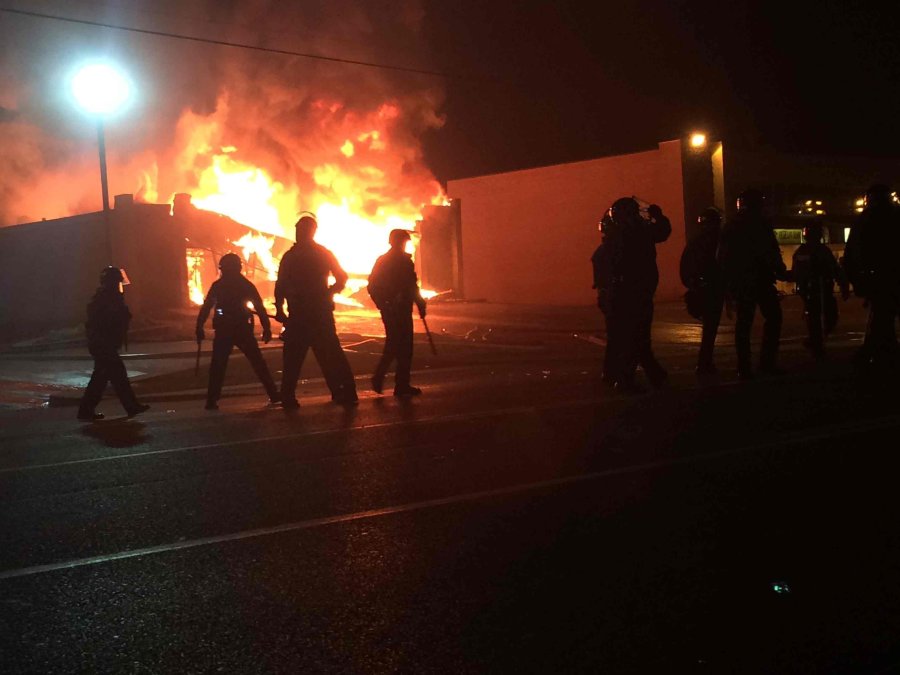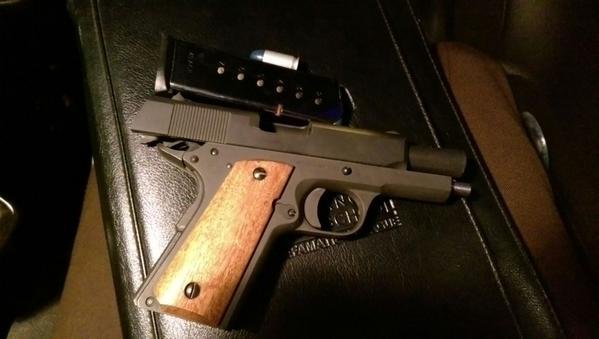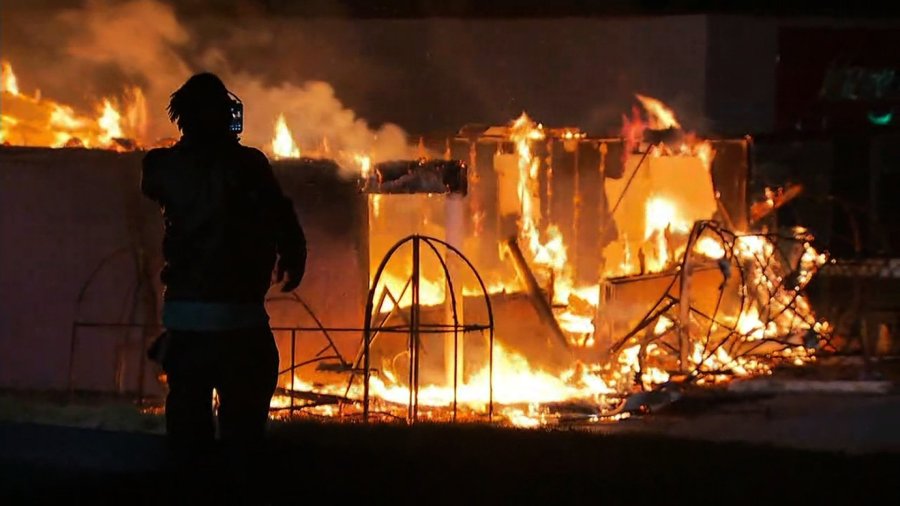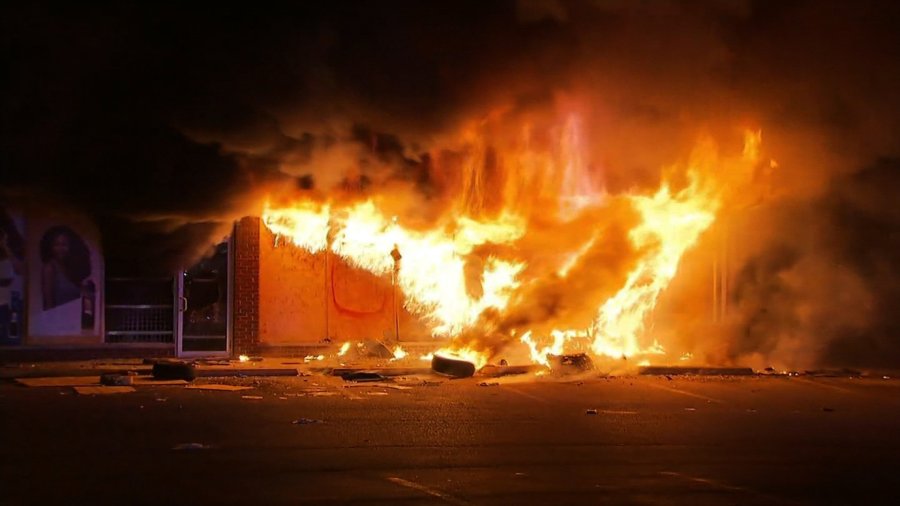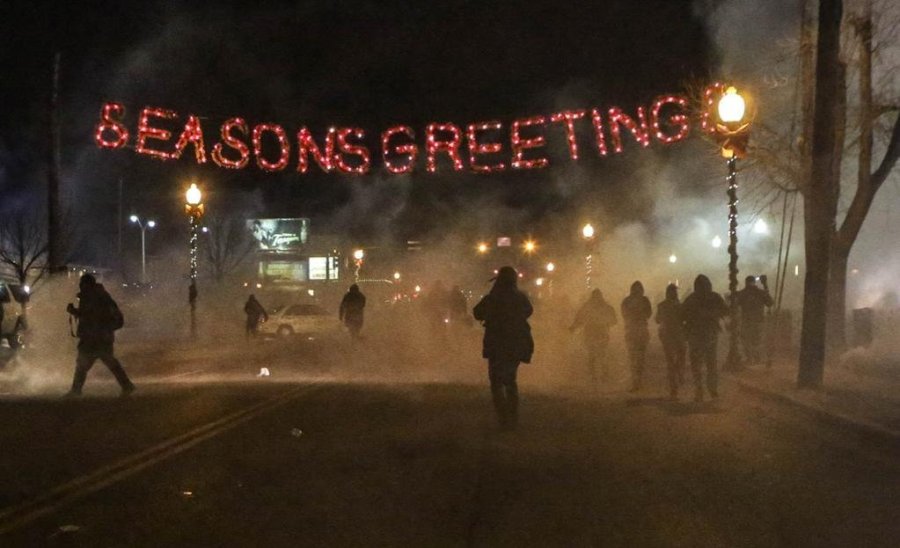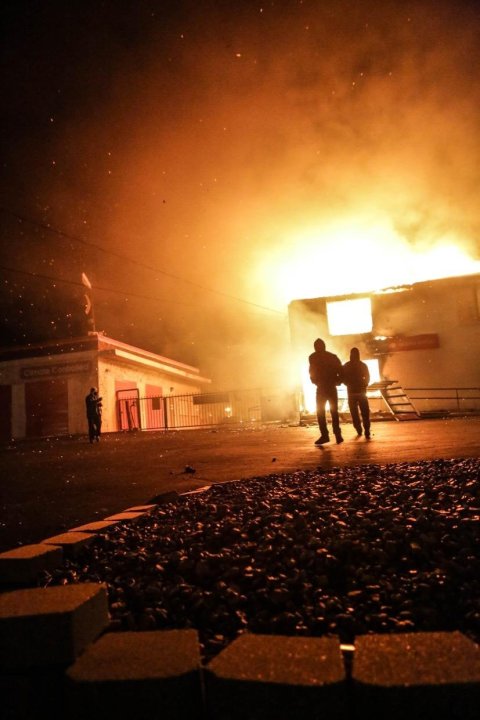FERGUSON, Mo. — More than a dozen buildings charred, set ablaze in a wave of fury. Stores — many owned by locals — looted, with shattered glass covering the asphalt outside. Shell casings on the ground, having been fired by unknown shooters.
Welcome to Ferguson, Mo.
This is what Tuesday looked like in Ferguson, hours after an eruption of rage over a grand jury’s decision not to indict Ferguson police Officer Darren Wilson in the August shooting death of 18-year-old Michael Brown.
Many of those who took to the streets late Monday into Tuesday to vent their feelings about racial injustice — rooted in the fact that Brown was black and Wilson is white — and police violence did so peacefully. Others did not, hurling bottles, batteries and rocks at police.
RELATED: What Darren Wilson told the grand jury
Authorities responded with round after round of tear gas, as well as shooting bean bags into the crowds.
“This ain’t Iraq,” Demetric Whitlock yelled to a line of police officers on South Florissant Road, in front of the Ferguson Police Department. “This is the United States.”
Yet images from the Missouri city looked like a war zone in another country. An entire row of businesses on West Florissant Avenue, a major thoroughfare, were engulfed in flames. Police cars and a row of vehicles at a nearby dealership were turned into fireballs. There were so many infernos that firefighters couldn’t get to every one.
There was also reports of gunshots: St. Louis County Police Chief Jon Belmar heard at least 100 through the night, though Missouri State Highway Patrol Capt. Ron Johnson insisted no bullets were fired by police. A CNN reporter was struck in the head with a bottle.
Six people were treated and released with minor injuries between 10 p.m. Monday and 4 a.m. Tuesday at nearby St. Louis’ Christian Hospital, spokesman Bret Berigan said. There were no known serious injuries — either to citizens or police officers — according to Belmar.
Police in Ferguson ended up making at least 61 arrests on charges ranging from unlawful assembly to burglary to unlawful possession of a firearm to arson.
By mid-Tuesday morning, the plazas were empty. Even the scene outside the police department — where Missouri National Guard members are providing security, under orders of Gov. Jay Nixon — was calm.
But no one was under the belief that the tensions, or the threats of more unrest, was gone.
“People here have a real grudge against the police,” Whitlock said. “It’s not going away.”
Protesters turn out nationwide
It wasn’t just that way in Ferguson.
Twelve miles south in St. Louis, Police Chief Sam Dotson said windows of businesses located across the street from a protest gathering spot were smashed and 21 people were arrested on felony accusations, including illicit gun possession. But no one was shot.
“What we saw last night is the criminals were using the cover of the organized protests to do their criminal activity,” Dotson said.
News about the grand jury’s decision not to indict Wilson also spread quickly nationwide, spurring others to turn out for spontaneous rallies in support of Brown’s family and against what they characterized as unnecessary force by some police against citizens, especially African-Americans.
Some laid down on the street outside the White House in protest. In New York’s Union Square, scores held up a huge, lit-up sign that read, “Black lives matter.” More protesters took their message to the streets of Seattle, Washington, and Oakland, California.
Others will get their chance to express their views more than 100 of pro-Brown family vigils and gatherings in cities big and small — from Los Angeles to Bangor, Maine — planned nationwide on Tuesday.
There is the chance that, in Ferguson or any of those places, violence could flare between protesters and police.
Weighing in during a live address Monday night, President Barack Obama called it “understandable” some Americans will agree and others will be made angry by the decision to not indict Wilson. Whatever their take, he said, lashing out is not an acceptable reaction.
“First and foremost, we are a nation built on the rule of law, so we need to accept this decision was the grand jury’s to make,” Obama said.
‘Exhaustive review’
All of this unrest, all of this tension dates to August 9, when Brown and a friend were walking down the middle of a Ferguson street.
What happened next — from the shooting, to the failure to immediately charge Wilson in Brown’s death, to at-times violent clashes between authorities and Brown family supporters — turned Ferguson from a largely unknown St. Louis suburb to the center of a national debate over race, law enforcement and the interaction of the two.
The basic facts have never been disputed, that Wilson shot Brown.
But how and why that exactly happened is hotly disputed. Grand jury testimony released late Monday offered little resolution, with Wilson’s version contradicting those offered by some witnesses.
The St. Louis County grand jury of nine white and three black members got a lot of information — meeting 25 times, during which they heard from 60 witnesses and three medical examiners in 70 hours of testimony.
The grand jurors’ mission was never to convict Wilson. Rather, it was to decide whether there was reason enough to charge him with a crime — either first-degree murder, second-degree murder, voluntary manslaughter and involuntary manslaughter. They also could have added a charge of armed criminal action. If at least nine of the 12 grand jurors had voted that there was enough to proceed with charges, Wilson would have stood trial.
After hearing all of the testimony and deliberating for two days, they decided not to indict the officer on any charge.
Said St. Louis County Prosecuting Attorney Robert McCulloch: “The physical and scientific evidence examined by the grand jury, combined with the witness statements, supported and substantiated by that physical evidence, tells the accurate and tragic story of what happened.”
A woman who helped run a support website for Wilson said Tuesday morning that she thinks the decision spurred “a sigh of relief across the entire law enforcement community.”
“Because they’re all fighting in the aftermath of this now,” said the woman, who wore sunglasses and a baseball cap to hide her identity, and asked not to be named. “And it could have been any one of them.”
Yet Piaget Crenshaw thinks the grand jury got it wrong. One of those who saw Brown get shot and who testified to the grand jury, she doesn’t understand how the teen could have been a deadly threat given that he was unarmed, while Wilson clearly was not.
“His hands were still visible in a manner (in which you could) tell he was unarmed,” Crenshaw said Tuesday, saying that witnesses’ discrepancies about the exact location of his hands were irrelevant. “(He) should not have been shot.”
Brown family: ‘Let’s make a difference’
The grand jury’s decision was welcomed by Wilson, who — in a statement issued by his attorneys — expressed thanks to those who have “stood by his side.”
“Law enforcement personnel must frequently make split-second and difficult decisions,” the Wilson camp’s statement said. “Officer Wilson followed his training and followed the law.”
The Ferguson police officer’s relief is in stark contrast with the feelings of the Brown family.
The decision not to indict Wilson “devastated” the late teenager’s father. His mother ran down the street, tears streaming down her face.
They still want something positive to come from their nightmare. But in a statement, the family stressed that one thing it did not want is violence.
“While we understand that many others share our pain, we ask that you channel your frustration in ways that will make a positive change,” the family said. “We need to work together to fix the system that allowed this to happen.”
The family made a call for police officers across the country to wear body cameras.
“Let’s not just make noise,” the family said, “let’s make a difference.”
Federal investigations
So what happens next?
The U.S. Justice Department is conducting two civil rights investigations in the case: one into whether Wilson violated Brown’s civil rights, and another into the police department’s overall track record with minorities.
The investigations will likely require lots of time, if similar past cases are any indication.
Back in Ferguson, residents worried about the toll Monday night’s violence has taken on the quaint revitalized downtown.
One of the casualties was Ferguson Optical. Earlier in the day, manager Tim Marrah had put out the sign he has been displaying since August: “We are family.”
It was no protection against vandals. A storefront window was shattered and left barely standing.
Peaceful protesters were shocked by the violence that has marred the city.
“This is crazy. I mean, this doesn’t do anything,” one resident said.
She worried about how victims would pick up the pieces.
“They’re not going to rebuild. It’s just going to be a ghost town pretty soon.”





